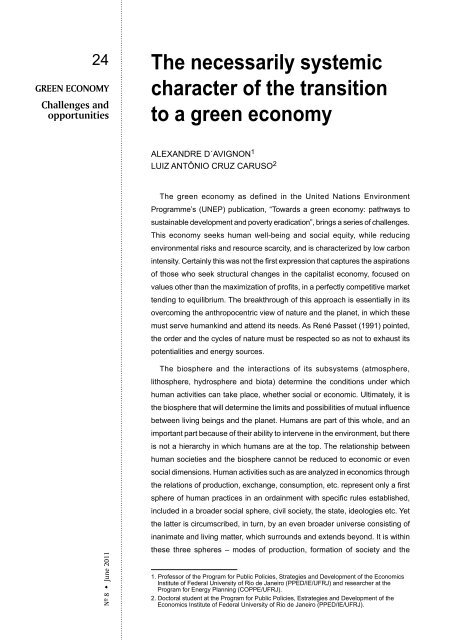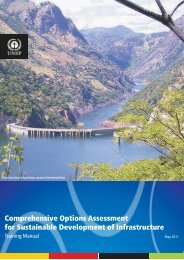Download Publication - Rio+20
Download Publication - Rio+20
Download Publication - Rio+20
You also want an ePaper? Increase the reach of your titles
YUMPU automatically turns print PDFs into web optimized ePapers that Google loves.
24<br />
GREEN ECONOMY<br />
Challenges and<br />
opportunities<br />
The necessarily systemic<br />
character of the transition<br />
to a green economy<br />
Alexandre d´Avignon 1<br />
Luiz Antônio Cruz Caruso 2<br />
The green economy as defined in the United Nations Environment<br />
Programme’s (UNEP) publication, “Towards a green economy: pathways to<br />
sustainable development and poverty eradication”, brings a series of challenges.<br />
This economy seeks human well-being and social equity, while reducing<br />
environmental risks and resource scarcity, and is characterized by low carbon<br />
intensity. Certainly this was not the first expression that captures the aspirations<br />
of those who seek structural changes in the capitalist economy, focused on<br />
values other than the maximization of profits, in a perfectly competitive market<br />
tending to equilibrium. The breakthrough of this approach is essentially in its<br />
overcoming the anthropocentric view of nature and the planet, in which these<br />
must serve humankind and attend its needs. As René Passet (1991) pointed,<br />
the order and the cycles of nature must be respected so as not to exhaust its<br />
potentialities and energy sources.<br />
Nº 8 • June 2011<br />
The biosphere and the interactions of its subsystems (atmosphere,<br />
lithosphere, hydrosphere and biota) determine the conditions under which<br />
human activities can take place, whether social or economic. Ultimately, it is<br />
the biosphere that will determine the limits and possibilities of mutual influence<br />
between living beings and the planet. Humans are part of this whole, and an<br />
important part because of their ability to intervene in the environment, but there<br />
is not a hierarchy in which humans are at the top. The relationship between<br />
human societies and the biosphere cannot be reduced to economic or even<br />
social dimensions. Human activities such as are analyzed in economics through<br />
the relations of production, exchange, consumption, etc. represent only a first<br />
sphere of human practices in an ordainment with specific rules established,<br />
included in a broader social sphere, civil society, the state, ideologies etc. Yet<br />
the latter is circumscribed, in turn, by an even broader universe consisting of<br />
inanimate and living matter, which surrounds and extends beyond. It is within<br />
these three spheres – modes of production, formation of society and the<br />
1. Professor of the Program for Public Policies, Strategies and Development of the Economics<br />
Institute of Federal University of Rio de Janeiro (PPED/IE/UFRJ) and researcher at the<br />
Program for Energy Planning (COPPE/UFRJ).<br />
2. Doctoral student at the Program for Public Policies, Estrategies and Development of the<br />
Economics Institute of Federal University of Rio de Janeiro (PPED/IE/UFRJ).

















